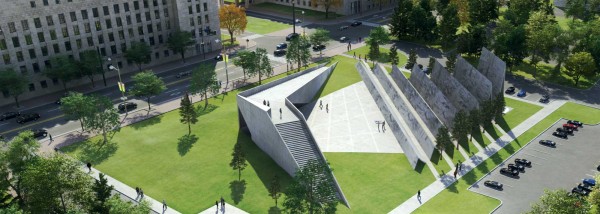triad: noun tri·ad \ˈtrī-ˌad also -əd\
1: a union or group of three : trinity
2: a chord of three tones consisting of a root with its third and fifth and constituting the harmonic basis of tonal music
The Jackson 5 said it best: “A-B-C, it’s easy as 1-2-3”
But easy is seemingly anything but the case when it comes to the government’s understanding of the highly contested and haughty debated site selection for the forthcoming ‘Memorial to the Victims of Communism’. Originally planned for a location further west along Wellington Street during its design phase – a site perhaps a little less prominent but still only a hop and a skip away from Parliament Hill – the plans for the memorial were later absurdly moved to land currently vacant, but slated to hold another federal court building.
However, what is apparently simple for all but those directly involved in the project to grasp is that while another court house may not be built anytime soon, the importance of the site in question goes beyond programmatic needs to the level of architectural and urban planning.
But with last week’s decision by the NCC to miniaturize the current design scheme rather than relocate it, after months of written protest and a strong critical response from the local and architectural communities (including the RAIC, OAA, and Ottawa architect Barry Padolsky), legal action is now being taken against the project.
As was made clearly evident in this month’s Urban Forum lecture on the ‘Long Term Vision and Plan: Parliamentary and Judicial Precincts’ given by Robert Allsopp (DTAH) and Lynette Fortin, the site currently being considered for the Memorial is needed to complete what is referred to as the ‘judicial triad’. Much like the three buildings which make up the ‘parliamentary triad’ – those being the Centre, East, and West Blocks – the judicial precinct currently consists of the Supreme Court of Canada and the Justice Building, with the final site lying in wait to complete this trinity of buildings.
The Long Term Vision and Plan (LTVP), a report that is meant to guide the urban and architectural development of Confederation Boulevard over the coming decades, also makes clear the importance of these buildings acting as pavilions in the landscape, as opposed to the continuous street edge created on the south side of Wellington. As such, the site sits primed and ready for such a building, in what Allsopp refers to as a “game of making picturesque compositions.”
Thus it truly is as simple as 1-2-3, with the established and approved (most recently in 2007) LTVP documenting the notion of the triad as a compositional planning principle, and indicating the strong need for a building, not a monument, to fulfill the framing of the Supreme Court. In doing so, the correct figure-ground relationship of the site’s spatial masses can finally be established.
However, if we turn to the dictionary it only becomes more defined, for it is in the very definition of the triad itself that we can understand the need for this final note of a building to complete the chord in perfect harmony.
This is not a confused architectural game. It is, in fact, more musical than anything. So let’s just make sure when we strike this final chord, we don’t hit a wrong note. Especially one that will last indefinitely.
***
Image: Tribute to Liberty

